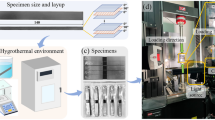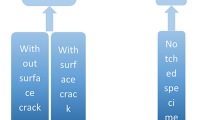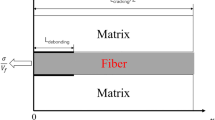Abstract
Results from an experimental program to investigate the propagation of damage and energy dissipation in 2D triaxially braided carbon fiber textile composites (2DTBC) under static conditions are reported. A methodology is presented in which classical concepts from fracture mechanics are generalized to address damage growth in an orthotropic and heterogeneous structural material. Along with results from the experimental program, a novel numerical technique that employs ideas from cohesive zone modeling, and implemented through the use of finite-element analysis, is also presented. The inputs that are required for the discrete cohesive zone model (DCZM) are identified. Compact tension specimen fracture tests and double notched tension tests were carried out to measure the fracture energy (G Ic), and the maximum cohesive strength (σ c), of the 2DTBC. The DCZM modeling strategy was independently verified by conducting single edge notched three-point bend tests using a modified three-point bend test fixture. The experimental and numerical analyses were carried out for two different types of 2DTBC made from the same textile architecture but infused with two different resin systems to validate the proposed methodology.












Similar content being viewed by others
References
Beard SJ, Chang FK (2002) Int J Crashworthiness 7(2):191. doi:https://doi.org/10.1533/cras.2002.0214
Quek SC, Waas AM, Shahwan KW, Agaram V (2003) Int J Mech Sci 45(6–7):1077. doi:https://doi.org/10.1016/j.ijmecsci.2003.09.003
Haywood JB (2006) Sci Am 295(3):94
Reifsnider KL, Case SW (2002) Damage tolerance and durability of material systems. Wiley
Gonzales L, Knauss WG (2002) Int J Fract 118(4):363. doi:https://doi.org/10.1023/A:1023351115322
Hertzberg J (1983) Deformation and fracture mechanics of engineering materials. Wiley
Xie D, Biggers SB Jr (2006) Eng Fract Mech 73:771. See also, Xie D, Biggers SB Jr (2006) Finite Elem Anal Design 42(11):977. doi:https://doi.org/10.1016/j.finel.2006.03.007
Xie D, Biggers SB Jr (2006) Eng Fract Mech 73:786. doi:https://doi.org/10.1016/j.engfracmech.2005.07.014
Xie D, Waas AM, Shahwan KW, Schroeder JA, Boeman RG (2004) Comput Model Eng Sci 6:515
Xie D, Waas AM (2006) Eng Fract Mech 73:1783. doi:https://doi.org/10.1016/j.engfracmech.2006.03.006
Xie D, Chung J, Waas AM, Shahwan KW, Schroeder JA, Boeman RG, Kunc V, Klett LB (2005) Int J Fract 134:231. doi:https://doi.org/10.1007/s10704-005-0646-y
Xie D, Salvi AG, Sun C, Waas AM, Caliskan A (2006) J Compos Mater 40:2025. doi:https://doi.org/10.1177/0021998306061320
Pietruszczak S, Mroz Z (1981) Int J Numer Methods Eng 17:327. doi:https://doi.org/10.1002/nme.1620170303
Ungsuwarungsri T, Knauss WG (1987) Int J Fract 5:221. See also PhD Thesis (1985) Aeronautics Department, Caltech, Pasadena, CA
Tvergaard V, Hutchinson JW (1992) J Mech Phys Solids 40:1377. doi:https://doi.org/10.1016/0022-5096(92)90020-3
Schellekens JCJ, de Borst R (1993) Int J Numer Methods Eng 36:43. doi:https://doi.org/10.1002/nme.1620360104
Xu XP, Needleman A (1994) J Mech Phys Solids 42:1397. doi:https://doi.org/10.1016/0022-5096(94)90003-5
Camacho GT, Ortiz M (1996) Int J Solids Struct 33:2899. doi:https://doi.org/10.1016/0020-7683(95)00255-3
Reedy ED, Mello FJ, Guess TR (1997) J Compos Mater 31:812
Pandolfi A, Krysl P, Ortiz M (1999) Int J Fract 95:279. doi:https://doi.org/10.1023/A:1018672922734
Espinosa HD, Zavattieri PD, Dwivedi SK (1998) J Mech Phys Solids 46:1909. doi:https://doi.org/10.1016/S0022-5096(98)00027-1
Zavattieri PD, Raghuram PV, Espinosa HD (1002) J Mech Phys Solids 49:27
Li S, Thouless MD, Waas AM, Schroeder JA, Zavattieri PD (2006) Eng Fract Mech 73:64
Gustafson PA, Waas AM (2007) “Experimental results and numerical analysis of high temperature bonded composite joints: Kriging sensitivity analysis of common adhesive tests”. ASME Congress presentation, November
Anderson TL (1995) Fracture mechanics, 2nd edn. CRC Press LLC
Salvi AG, Waas AM, Caliskan A (2004) Polym Compos 25(4):397
Salvi AG, Waas AM, Caliskan A (2004) Compos Sci Technol 64:83
Turner TA, Warrior NA, Robitaille F (2005) Compos A Appl Sci Manuf 36(9):1291
Acknowledgements
The authors are grateful for the financial sponsorship of the Automotive Composites Consortium, Energy Management Working Group, and the Department of Aerospace Engineering, University of Michigan. The authors acknowledge that this research was supported, in whole or in part, by Department of Energy cooperative agreement no. DE-FC05-95OR22363. Such support does not constitute an endorsement by the Department of Energy of the views expressed herein.
Author information
Authors and Affiliations
Corresponding author
Appendix: measurement of the plasticity parameter a 66
Appendix: measurement of the plasticity parameter a 66
The plastic response of braided composites was characterized by carrying out off-axis compression tests. Rectangular composite coupons were cut in such a way that the axial fiber tow makes an angle with the direction of loading as shown below.
A three-strain gage rosette was used to measure the global strains that are then transformed to get the local strains in the specimen principal material directions. Axial stress is also measured during the test. A yield function or plastic potential that is quadratic in stresses for a orthotropic composite gives an equivalent stress and a work conjugate equivalent plastic strain as
where, \( \ifmmode\expandafter\bar\else\expandafter\=\fi{\sigma } \) is the Von Mises type equivalent stress, \( {\text{d}}\ifmmode\expandafter\bar\else\expandafter\=\fi{\varepsilon }^{p} \) is the equivalent plastic strain increment, and dλ is a scalar factor of proportionality. The parameters a 22 and a 66 are the material constants that characterize orthotropy of the plastic response.
Substituting, using stress transformations, into Eq. 6a–c to specialize to the off-axis compression test configuration, results in
or
Similarly,
where, m = cos(θ), n = sin(θ), and \( h{\left( \theta \right)} = {\sqrt {\frac{3} {2}{\left( {n^{4} + 2a_{{66}} m^{2} n^{2} } \right)}} }. \)
Off-axis tests were carried out on 30, 60, and 75° specimens. Thus, from experimental measurement of σ y and ε y, the equivalent stress and equivalent plastic strain are plotted for every off-axis angle. For each test, a value of a 66 is selected such that the curves of equivalent stress versus equivalent plastic strain for each off-axis angle collapses to one. Test data for different off-axis angles for Epon specimens are given in Fig. 10. The value of a 66 corresponding to this converged behavior was found to be 1.1. Similarly, value of a 66 for Hetron specimens was found to be to be 1.2.
Rights and permissions
About this article
Cite this article
Salvi, A.G., Waas, A.M. & Caliskan, A. Energy absorption and damage propagation in 2D triaxially braided carbon fiber composites: effects of in situ matrix properties. J Mater Sci 43, 5168–5184 (2008). https://doi.org/10.1007/s10853-008-2684-0
Received:
Accepted:
Published:
Issue Date:
DOI: https://doi.org/10.1007/s10853-008-2684-0





